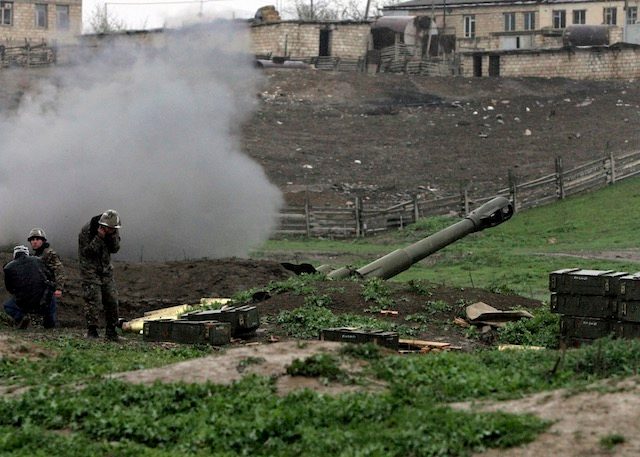SUMMARY
This is AI generated summarization, which may have errors. For context, always refer to the full article.

STEPANAKERT, Azerbaijan – Azerbaijan and Armenian separatists in Nagorno-Karabakh on Tuesday, April 5, announced a ceasefire after 4 days of bloodshed, as international powers scrambled to end the worst violence in decades over the disputed region.
The two sides said they had agreed to halt fighting from 0800 GMT after clashes since Friday, April 1, left at least 73 people dead, but Armenia’s defense ministry claimed there was still “sporadic shooting” going on.
Key regional powerbroker Russian President Vladimir Putin called the leaders of ex-Soviet Armenia and Azerbaijan after the ceasefire agreement and told them to “ensure” an end to the violence.
“Putin called on both sides to urgently ensure a complete cessation of military hostilities and respect for the ceasefire,” the Kremlin said after Putin spoke to the two presidents separately by telephone.
On a visit to a hospital to meet wounded soldiers Azerbaijan’s President Ilham Aliyev said the conflict could still be resolved peacefully if Armenia’s leadership “behaves sincerely at the negotiating table”.
The “Minsk Group” of the US, French, and Russian ambassadors to the Organization for Security and Cooperation in Europe (OSCE), which has long mediated Karabakh peace talks, urged both sides to respect the truce after meeting in Vienna.
The Minsk Group co-chairs “stressed that it is important to return to the political process on the basis of a sustainable ceasefire.”
The US State Department welcomed the ceasefire and said it fully supported the work of the group.
“There is an established process here,” US spokesman Mark Toner said. “We’ve had a complete breakdown, a violation, of the existing ceasefire. We now have a new one in place. It needs to be adhered to.”
In a flurry of diplomacy the mediators are heading to the region to shuttle between the two warring sides, while Russian Prime Minister Dmitry Medvedev is set to travel to both Yerevan and Baku in the coming days.
Russia’s foreign ministry also said that the top diplomats from Russia, Iran and Azerbaijan will focus on the conflict when they meet for planned talks in Baku on Thursday, April 7, RIA Novosti reported.
Changing the frontline
On the ground, an Agence France-Presse photographer in the frontline Azeri town of Terter said that both sides appeared to have stopped shelling Tuesday afternoon after a night of sporadic artillery fire across the front.
At the Karabakh army checkpoint near the Iranian border, shelling halted as well around midday, another Agence France-Presse photographer said.
The fragile truce comes after Azerbaijan’s army claimed to have snatched control of several strategic locations inside Armenian-controlled territory, effectively changing the frontline for the first time since an inconclusive truce ended a war in 1994.
But Yerevan said the Azeri side no longer held any Armenian territory.
“Even if certain Armenian positions were at some point taken by Azeris, now they are all returned under Karabakh’s control,” Armenia’s defence ministry spokesman Artsrun Hovhannisyan told Agence France-Presse.
Azerbaijan’s ambassador to the United States, Elin Suleymanov, told Agence France-Presse Armenia had provoked the conflict to overshadow Baku’s successful diplomacy.
Last week Aliyev received a warm welcome to Washington at President Barack Obama’s Nuclear Security Summit.
Suleymanov dubbed this “one of the most positive days” in US-Azerbaijan relations and thanked Secretary of State John Kerry for backing Azerbaijan’s territorial integrity.
“So, history shows that every time something like this happens, there is a provocation that overshadows that success,” he complained.
“This time with the summit just finished and President Aliyev still in transit back home – he hadn’t even landed – when the escalation began.”
In updated death tolls Tuesday evening, Azerbaijani authorities told AFP 31 soldiers and two civilians on their side had died. Rebel Karabakh officials said 35 Armenian fighters and five civilians were killed.
Regional fears
Both sides accused each other of starting the latest outbreak which has sparked concern of a wider conflict that could drag in Russia and Turkey.
While Moscow has sold arms to both sides, it has a military alliance with and a base in, Armenia and far closer ties to Yerevan.
Turkey – which is locked in a feud with Moscow after Ankara downed a Russian warplane in Syria in November – has pledged its full support for traditional ally Azerbaijan, with Prime Minister Ahmet Davutoglu vowing to stand by Baku “until the apocalypse.”
Washington refused to comment on NATO ally Turkey’s rhetoric, but Toner insisted that the Minsk process “does not include taking sides or picking one side over another.”
Security alliance NATO called on all sides to “show restraint and prevent any new escalation.”
Separatists backed by Yerevan seized control of mountainous Nagorno-Karabakh, a majority ethnic Armenian region lying inside Azerbaijan, in an early 1990s war after the Soviet Union crumbled that claimed some 30,000 lives.
The sides have never signed a peace deal despite the 1994 ceasefire and sporadic violence on the line of contact regularly claims the lives of soldiers on both sides.
Energy-rich Azerbaijan, whose military spending exceeds Armenia’s entire state budget, has repeatedly threatened to take back the breakaway region by force. – Karen Minasian with Tofik Babayev in Terter and Simon Sturdee in Vienna, Austria, AFP / Rappler.com
Add a comment
How does this make you feel?
There are no comments yet. Add your comment to start the conversation.